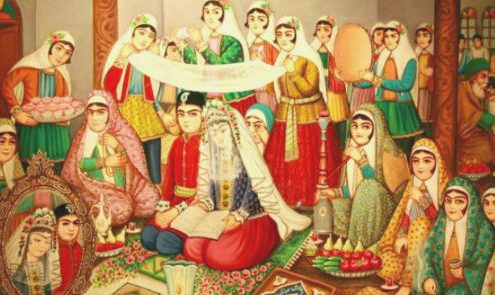Ceremonies in Iran

Traditional Ceremonies: Wedding Party
Like in any other cultures, since very ancient times, Iranians have also had special occasions to celebrate and revive traditions. Feasts are not necessarily happy gatherings. At times, people gather together to commemorate and honor an event a person, etc.
The Categorization of Feasts in Iran
Here is a categorization of the gatherings in Iran:
- Ancient, Mythical and seasonal feasts;
- Religious feasts;
- National and Governmental feasts;
- Family feats; and,
- Regional feasts.
The most commonly celebrated feasts, at present, in Iran are briefly introduced here.
Since ancient times, many feasts were accompanied by myths or legends as their sources of origination like Nowruz, Tirgan, Mehrgan, Yalda and Sadeh.
Some Ceremonies in Iran
Nowruz
When the Sun reaches the vernal equinox on the meridian, the 20th or 21st of March, days and nights are approximately equal. This very same day has long been called Nowruz (“now” means new and “ruz” means day). Since thousands of years ago, Iranians knew this and regarded it as the first day of the New Year in Iranian solar calendar.
The first mythical king, Jamshid, is said to have celebrated this occasion as the beginning of his establishing justice and defeating demons.
To celebrate Nowruz, there are some preparatory traditions observed by Iranians like: last Wednesday feast (firecrackers, etc), deceased day and the last Thursday (Honoring the Deceased in the cemeteries, etc), khaneh tekany (house cleaning, etc), cereal planting, haftseen (special combination of symbolic stuff at everyone’s home), new clothes, Nowruz dishes, visiting each other, the first Nowruz, its presents, its post cards, Sizdah-Beh-Dar (national day for picnicking) and so forth.
Tirgan
At the evening of the 12th day of the fourth month of their own calendar (Tir), the 2nd or 3rd of July, people in Mazandaran province celebrate Tirgan. Tir means arrow and Titgan refers to the occasion when Arash, the legendary bowman, shot an arrow to indicate the borderline between Iran and Turan. Arash lost his entire energy and died afterward. The feast includes many traditions like plays, poem reading, singing, eating, drinking, etc.
Mehrgan
Mehr is the 7th month of Iranian calendar, app Sept 21st to Oct 20th, and the name of the goddess of the Sun. At this harvest time, Zoroastrian people in Kerman celebrate the occasion by sacrificing a sheep or a chicken and honor it by feasting, etc.
Yalda (Chelleh)
It is the longest night of the year, the 21st or 22nd of September, and as some believe, the birthday of Mehr the undefeatable. They said at the end of this night, darkness is defeated and light gains victory. It is also the day of harvesting crops and the beginning of farmers’ rest period.
People gather together in the house of the eldest member of the entire family enjoying themselves eating summer fruits as well as nuts. They also read poems of Hafez and have a lot of chat.
Sadeh
It means emergence and refers to forty days after the birth of Mehr, 10th of Bahman (Jan 29th or 30th). People celebrate this occasion by setting huge fire outside some cities that, of course, can be interpreted differently. It is not celebrated by the whole nation nowadays.
Sadeh is a very ancient non-religious celebratory occasion during which all religions take part in the feast, have a special soup, and eat nuts and fruits. They all wear colorful clothes and make-ups and enjoy themselves.
Pir-e-Chak-Chak
It is a pilgrimage site for the Zoroastrians from all around the world who gather together at the 62km northeast of Yazd at the heart of desert once a year in the 21st or 22nd of June.
During their stay there, they go two or three times to the temple with their heads covered. They burn candles, pray, vow, wear special white dresses and bands around their waists. Votive soup and bread are served for everyone in addition to other foodstuff.
It is also a time for renewing the meetings, entertaining, water sprinkling, etc. Note that water sprinkling is customary in different parts of Iran during Nowruz or other feasts.
Qara Kelisa
It is a famous ancient church near Maku, West Azerbaijan province in Iran. Qara Kelisa or Tade’oos church is a pilgrimage site for the Armenians who go there as groups or families after mid August each year.
They stay there at least for three days of feasting, praying, singing in choir, entertaining, dancing, horse/mule/donkey ridding, etc.
Armenians who converted to Christianity in 300 were an ethnic group within the Iranian empire and Tade’oos is said to have been Jesus disciple who was evangelizing, was martyred and buried there. Later, this church was built at his burial place.
Carpet Washing in Mashad-e-Ardehal
To commemorate the martyrdom of one the descendants of the 5th Imam of Shiite Twelvers, people around Ardehal and Kashan perform a special ceremony once a year. It includes washing the carpet of his mausoleum in the spring nearby to commemorate the event during which the dead body was wrapped in a carpet and later the carpet was washed there.
During the ceremony, people also damn his enemies who murdered him and wave clubs up in the air to show their feeling of hatred toward his enemies. The feast includes going on picnic, shopping, etc. But it is a very unique feast because of its peculiar ceremonies.
Other Sites & Rites
There are thousands of tombs in Iran in which the descendants of Imams are buried. That is why there are called Imamzadeh (born of Imam). They are pilgrimage sites for Shiites, both local and non-local people. Some of the buildings of these tombs are very old, for example, 800 year old.
In each area of Iran, various ethnic and religious groups are living at the same neighborhood. Therefore, there can be found different varieties of the same feasts or different local ones.
